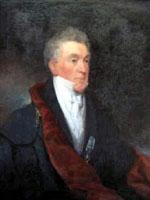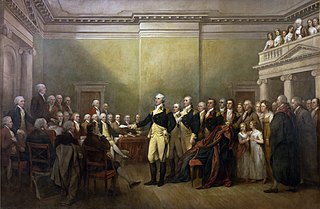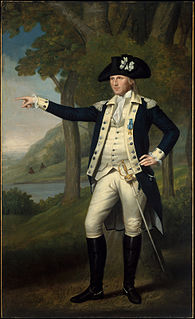 W
WGeorge Clinton was an American soldier and statesman, considered one of the Founding Fathers of the United States. A prominent Democratic-Republican, Clinton served as the fourth vice president of the United States from 1805 until his death in 1812. He also served as governor of New York from 1777 to 1795 and from 1801 to 1804. Along with John C. Calhoun, he is one of two vice presidents to hold office under two presidents.
 W
WMajor General James Clinton was an American Revolutionary War officer who, with John Sullivan, led in 1779 the Sullivan Expedition in what is now western New York to attack British-allied Seneca and other Iroquois villages. They destroyed 40 villages, as well as their winter stores of wheat and other produce. He obtained the rank of brevet major general.
 W
WJoseph Louis Cook, or Akiatonharónkwen (Mohawk), was an Iroquois leader and commissioned officer in the Continental Army during the American Revolution. Born to an African father and an Abenaki mother in what is now Schuylerville, New York, he and his mother were taken captive in a French-Mohawk raid and taken to Kahnawake, a Mohawk village south of Montreal. They were adopted by a Mohawk family. His mother soon died and he served Catholic missionaries, learning French. He became an influential leader among the Mohawk and distinguished himself as a warrior for their allies the French during the French and Indian War.
 W
WSimeon De Witt was Geographer and Surveyor General of the Continental Army during the American Revolution and Surveyor General of the State of New York for the fifty years from 1784 until his death.
 W
WNicholas Fish was an American Revolutionary War soldier. He was the first Adjutant General of New York.
 W
WPeter Gansevoort was a Colonel in the Continental Army during the American Revolutionary War. He is best known for leading the resistance to Barry St. Leger's Siege of Fort Stanwix in 1777. Gansevoort was also the maternal grandfather of Moby-Dick author Herman Melville.
 W
WAlexander Hamilton was a Caribbean-born American statesman, politician, legal scholar, military commander, lawyer, banker, and economist. He was one of the Founding Fathers of the United States. He was an influential interpreter and promoter of the U.S. Constitution, as well as the founder of the nation's financial system, the Federalist Party, the United States Coast Guard, and the New York Post newspaper. As the first secretary of the treasury, Hamilton was the main author of the economic policies of President George Washington's administration. He took the lead in the federal government's funding of the states' debts, as well as establishing the nation's first two de facto central banks, a system of tariffs, and friendly trade relations with Britain. His vision included a strong central government led by a vigorous executive branch, a strong commercial economy, support for manufacturing, and a strong military.
 W
WJohn Lamb (1735–1800) was an American soldier, politician, and Anti-Federalist organizer. During the American Revolutionary War he led the 2nd Continental Artillery Regiment.
 W
WJohn Laurance was a delegate to the 6th, 7th and 8th Congresses of the Confederation, a United States Representative and United States Senator from New York and a United States District Judge of the United States District Court for the District of New York.
 W
WMorgan Lewis was an American lawyer, politician, and military commander. The second son of Francis Lewis, a signer of the Declaration of Independence, Lewis fought in the American Revolutionary War and the War of 1812. He served in the New York State Assembly and the New York State Senate (1811–1814) and was New York State Attorney General (1791–1801) and governor of New York (1804–1807).
 W
WHenry Brockholst Livingston was an American Revolutionary War officer, a justice of the New York Court of Appeals and eventually an Associate Justice of the Supreme Court of the United States.
 W
WGeneral William Malcolm was a New York City merchant and officer in the American Revolution. He commanded Malcolm's Regiment, with Aaron Burr as his second in command.
 W
WAlexander McDougall was a Scottish-born American seaman, merchant, a Sons of Liberty leader from New York City before and during the American Revolution, and a military leader during the Revolutionary War. He served as a major general in the Continental Army, and as a delegate to the Continental Congress. After the war, he was the president of the first bank in the state of New York and served a term in the New York State Senate.
 W
WRichard Montgomery was an Irish soldier who first served in the British Army. He later became a major general in the Continental Army during the American Revolutionary War, and he is most famous for leading the unsuccessful 1775 invasion of Quebec.
 W
WLt. Col. Stephen Moulton and his sons fought in one of the most pivotal battles of the American Revolutionary War.
 W
WHenry Rutgers was a United States Revolutionary War hero and philanthropist from New York City. Rutgers University was named after him, and he donated a bond which placed the college on sound financial footing. He also gave a bell that is still in use today.
 W
WJoshua Sands was an American merchant and politician. He was a U.S. Representative from New York.
 W
WPhilip John Schuyler was an American general in the Revolutionary War and a United States Senator from New York. He is usually known as Philip Schuyler, while his son is usually known as Philip J. Schuyler.
 W
WWilliam Stephens Smith was a United States Representative from New York. He married Abigail "Nabby" Adams, the daughter of President John Adams, and so was a brother-in-law of President John Quincy Adams and an uncle of Charles Francis Adams Sr.
 W
WJohn Jacob Van Arsdale (1756-1836) was an American Revolutionary War soldier, noted for his legendary participation in the Evacuation Day flag-raising in 1783. From Cornwall, New York, he participated in the Benedict Arnold's expedition to Quebec and the unsuccessful Battle of Quebec in 1775. He was later captured in the defensive Battle of Forts Clinton and Montgomery in 1777, and was detained by the British for nine and one-half months, including two months in the sugar house prisons, before being released in a prisoner exchange.
 W
WPhilip Van Cortlandt was an American surveyor, landowner, and politician from Westchester County, New York. Van Cortlandt was the son of Pierre Van Cortlandt and brother of Pierre Van Cortlandt, Jr. He was a Continental Army officer during the American Revolution, and later served several terms in the United States House of Representatives.
 W
WRichard Varick was an American lawyer, military officer, and politician who has been referred to as "The Forgotten Founding Father." A major figure in the development of post-Independence New York City and State, Varick became the 45th Mayor of New York City in 1789 and served eleven consecutive one-year terms until 1801.
 W
WCaptain Benjamin Walker was a soldier in the American Revolutionary War and later served as a U.S. Representative from New York.
 W
WMarinus Willett was an American soldier and political leader from New York. He was characterized by historian Mark M. Boatner as "one of the truly outstanding American leaders of the Revolution."